
Question and Answers Forum
Question Number 50352 by mr W last updated on 16/Dec/18
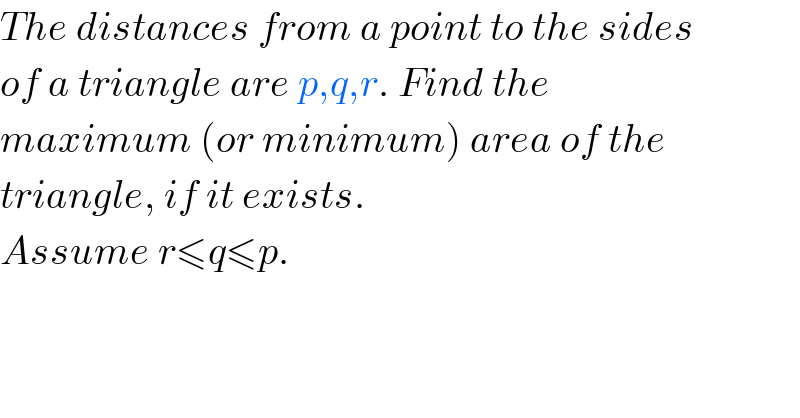
Commented by ajfour last updated on 16/Dec/18
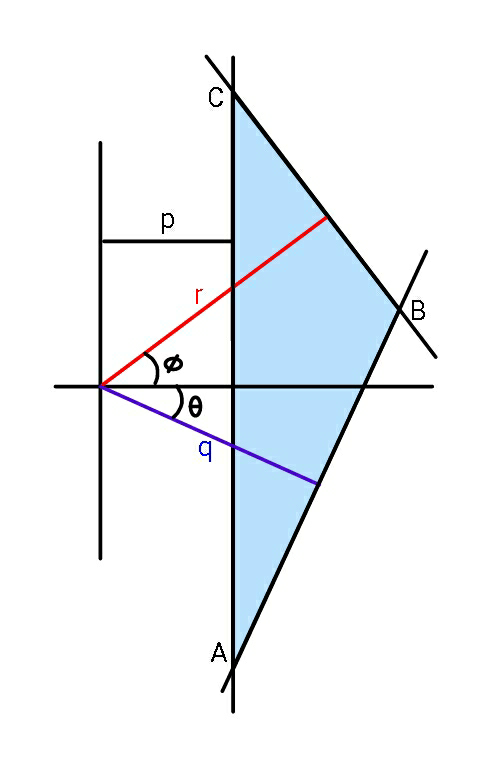
Commented by ajfour last updated on 17/Dec/18
![D[rcos θ−pcos (θ+φ)]=Nsin φsin (2θ+φ) xcos θ−ysin θ = q eq. of BC xcos φ+ysin φ = r y_C = ((r−pcos φ)/(sin φ)) , y_A = ((pcos θ−q)/(sin θ)) x_B = ((qsin φ+rsin θ)/(sin (θ+φ))) △ = (((x_B −p)/2))(y_C −y_A ) = [((qsin φ+rsin θ−psin (θ+φ))/(2sin (θ+φ)))] ×[((qsin φ+rsin θ−psin (θ+φ))/(sin θsin φ))] ___________________________ △ = (([qsin φ+rsin θ−psin (θ+φ)]^2 )/(2sin (θ+φ)sin θsin φ)) ___________________________](Q50487.png)
Commented by ajfour last updated on 16/Dec/18

Commented by mr W last updated on 16/Dec/18

Commented by mr W last updated on 17/Dec/18
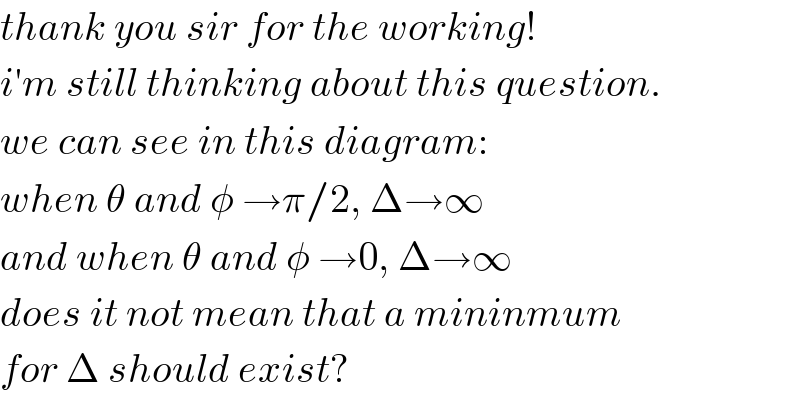
Answered by mr W last updated on 16/Dec/18
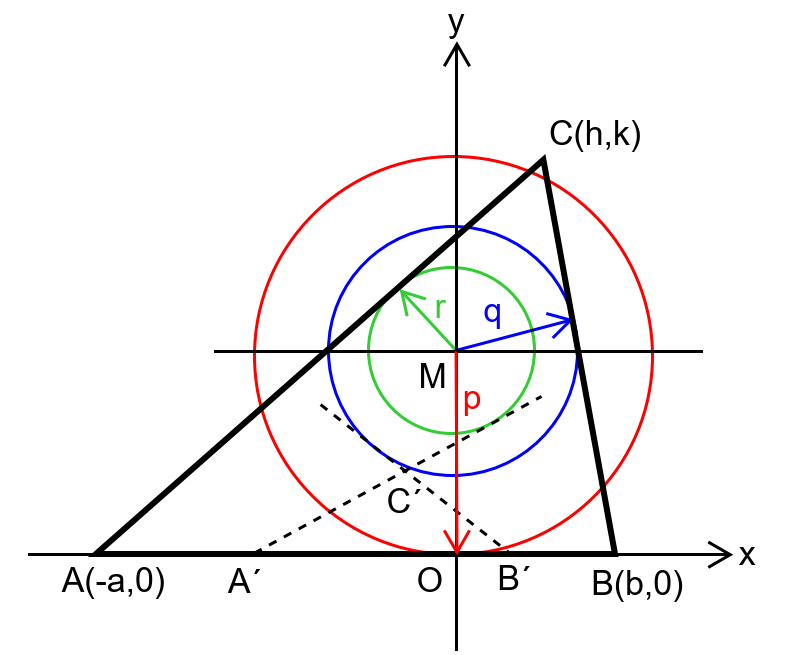
Commented by mr W last updated on 16/Dec/18
![draw three circles from the same center with radii p,q,r. it is to find a triangle whose sides tangent these three circles and has maximum area (like ΔABC) or minimum area (like ΔA′B′C′). A(−a,0) and B(b,0) and C(h,k). Eqn. of AC: (y/k)=((x+a)/(h+a)) ⇒(k/(h+a))x−y+((ak)/(h+a))=0 Eqn. of circle with radius r: x^2 +(y−p)^2 =r^2 AC is tangent, ⇒((k/(h+a)))^2 r^2 +r^2 =(−p+((ak)/(h+a)))^2 =p^2 −2pa((k/(h+a)))+a^2 ((k/(h+a)))^2 ⇒(a^2 −r^2 )((k/(h+a)))^2 −2pa((k/(h+a)))+(p^2 −r^2 )=0 ⇒(k/(h+a))=((pa±(√(p^2 a^2 −(a^2 −r^2 )(p^2 −r^2 ))))/(a^2 −r^2 ))=((pa±r(√(p^2 −r^2 +a^2 )))/(a^2 −r^2 )) we consider at first the big triangle, ⇒(k/(h+a))=((pa+r(√(p^2 −r^2 +a^2 )))/(a^2 −r^2 )) ⇒h=((a^2 −r^2 )/(pa+r(√(p^2 −r^2 +a^2 ))))k−a Eqn. of BC: (y/k)=((x−b)/(h−b)) ⇒(k/(h−b))x−y−((bk)/(h−b))=0 Eqn. of circle with radius q: x^2 +(y−p)^2 =q^2 BC is tangent, ⇒((k/(h−b)))^2 q^2 +q^2 =(−p−((bk)/(h−b)))^2 =p^2 +2pb((k/(h−b)))+b^2 ((k/(h−b)))^2 ⇒(b^2 −q^2 )((k/(h−b)))^2 +2pb((k/(h−b)))+(p^2 −q^2 )=0 ⇒(k/(h−b))=((−pb+q(√(p^2 −q^2 +b^2 )))/(b^2 −q^2 )) ⇒h=((b^2 −q^2 )/(−pb+q(√(p^2 −q^2 +b^2 ))))k+b ⇒((a^2 −r^2 )/(pa+r(√(p^2 −r^2 +a^2 ))))k−a=((b^2 −q^2 )/(−pb+q(√(p^2 −q^2 +b^2 ))))k+b ⇒[((a^2 −r^2 )/(pa+r(√(p^2 −r^2 +a^2 ))))−((b^2 −q^2 )/(−pb+q(√(p^2 −q^2 +b^2 ))))]k=a+b ⇒k=((a+b)/(((a^2 −r^2 )/(pa+r(√(p^2 −r^2 +a^2 ))))−((b^2 −q^2 )/(−pb+q(√(p^2 −q^2 +b^2 )))))) area of ΔABC Δ=(1/2)(a+b)k ⇒Δ=(1/2)×(((a+b)^2 )/(((a^2 −r^2 )/(pa+r(√(p^2 −r^2 +a^2 ))))−((b^2 −q^2 )/(−pb+q(√(p^2 −q^2 +b^2 )))))) (∂Δ/∂a)=(∂Δ/∂b)=0 ......](Q50486.png)
Commented by mr W last updated on 17/Dec/18
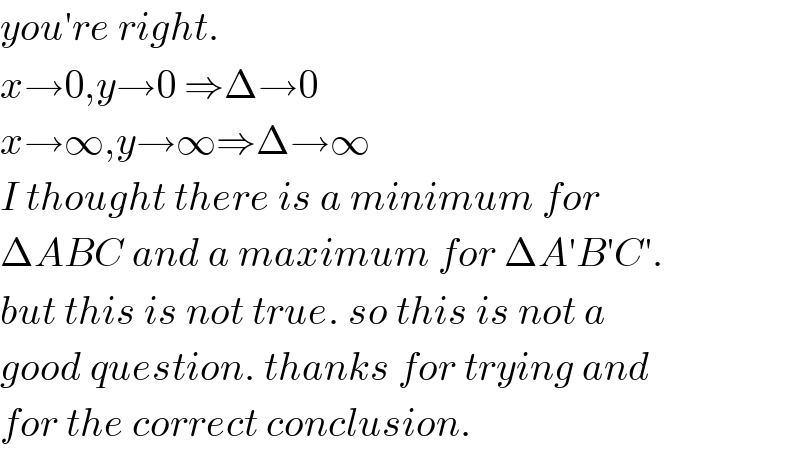
Commented by ajfour last updated on 17/Dec/18

